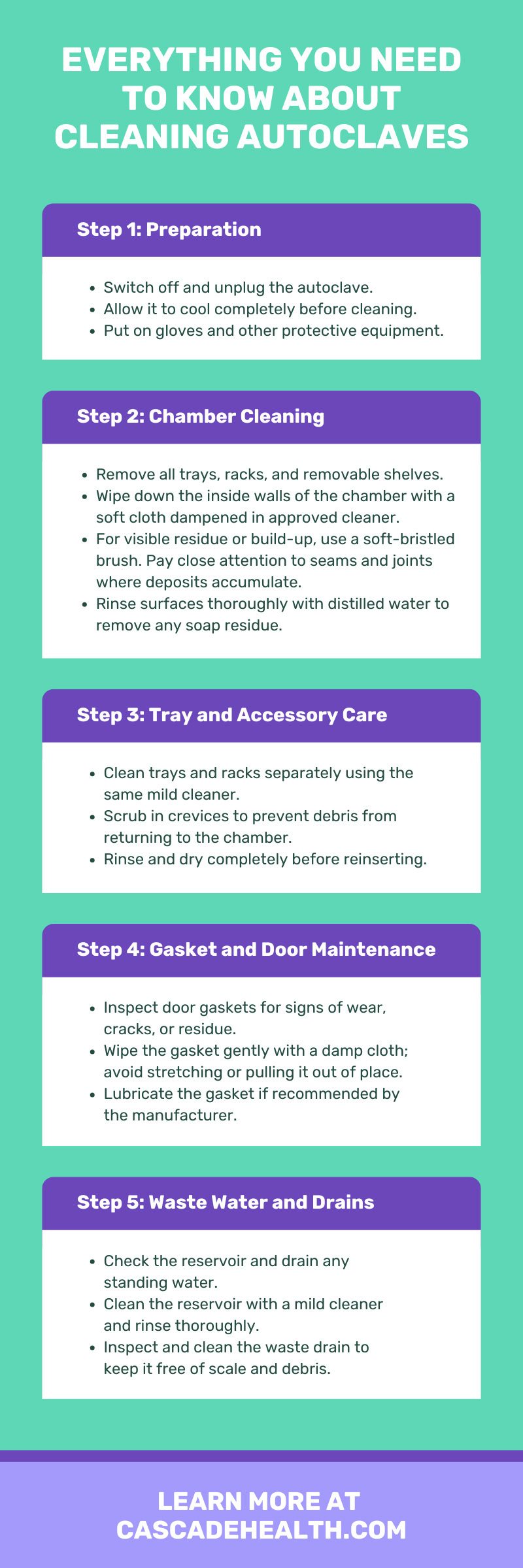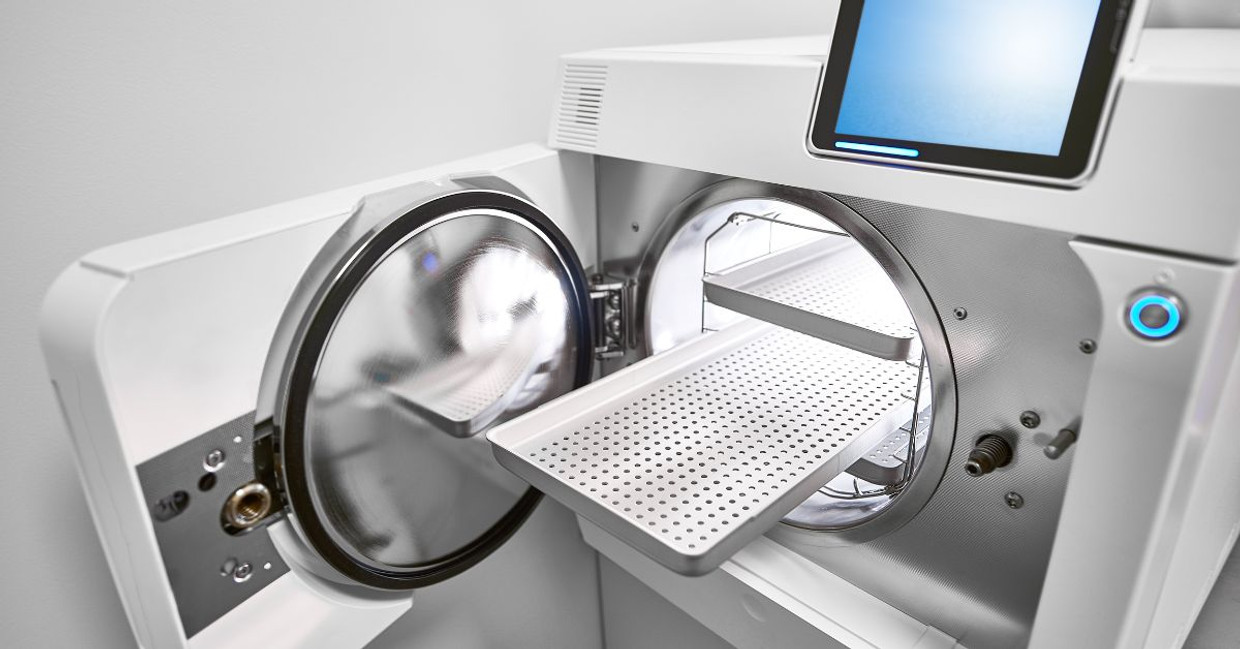Everything You Need To Know About Cleaning Autoclaves
Sterilization protocols rank among the highest priorities within healthcare settings. Medical autoclaves play a central part in maintaining sterile environments, protecting patients and staff by eliminating potentially harmful pathogens on surgical instruments and equipment. Cleaning these machines is fundamental to safe, uninterrupted operations. This guide will cover everything you need to know about cleaning autoclaves so you can implement best practices for ongoing care.
Understanding Autoclaves
A medical autoclave is a machine that uses pressurized steam to sterilize instruments, dressings, and medical waste. By exposing equipment to high temperatures and moisture under pressure, autoclaves destroy bacteria, viruses, fungi, and spores that might survive conventional cleaning methods.
Most autoclaves operate by heating water to create steam, then locking that steam inside a chamber. Pressure inside the chamber increases, allowing the steam to reach higher temperatures than boiling water. This high-temperature steam penetrates complex instruments and eliminates pathogens within minutes.
Healthcare relies on these devices to ensure sterile fields during surgical procedures, wound care, and laboratory work. Clean, functioning autoclaves help hospitals, clinics, and labs meet regulatory standards for infection control.
Why Cleaning Your Autoclave Matters
Neglected cleaning routines quickly lead to a buildup of debris, mineral deposits, and biological material. This residue interferes with performance and puts patients and staff at risk. Dirty autoclaves can cause incomplete sterilization, exposing users to infection and increasing the potential for costly downtime and equipment failure.
Regular cleaning brings several important benefits:
- Prevents contamination: Removing residue and debris ensures that nothing interferes with steam penetration during sterilization.
- Extends lifespan: Corrosive buildup and scale diminish the efficiency and longevity of vital components.
- Improves operation: Clean autoclaves reach proper temperatures and pressures, supporting accurate sterilization cycles and reducing error rates.
Missed cleaning schedules and improper maintenance can cause test failures, unpleasant odors, and inconsistent performance. These problems are preventable with the right cleaning habits.
Essential Supplies for Cleaning
Equipping staff with the proper materials reduces the risk of damaging sensitive autoclave parts. Avoid harsh chemicals or abrasive tools that can corrode or scratch internal components.
Recommended cleaning supplies include:
- Lint-free soft cloths or wipes
- Non-abrasive sponges and brushes
- Manufacturer-approved detergent or mild, neutral pH cleaner
- Distilled or deionized water for rinsing
- Personal protective equipment (gloves, safety glasses)
Always consult the manufacturer's manual for your model. Using unauthorized chemicals or ignoring cleaning guidelines voids warranties and can shorten the service life of the equipment.
Step-by-Step Cleaning Guide
Good cleaning procedures keep autoclaves reliable and safe for everyday operation. Below is a practical workflow for routine cleaning between sterilization cycles:
Step 1: Preparation
- Switch off and unplug the autoclave.
- Allow it to cool completely before cleaning.
- Put on gloves and other protective equipment.
Step 2: Chamber Cleaning
- Remove all trays, racks, and removable shelves.
- Wipe down the inside walls of the chamber with a soft cloth dampened in approved cleaner.
- For visible residue or build-up, use a soft-bristled brush. Pay close attention to seams and joints where deposits accumulate.
- Rinse surfaces thoroughly with distilled water to remove any soap residue.
Step 3: Tray and Accessory Care
- Clean trays and racks separately using the same mild cleaner.
- Scrub in crevices to prevent debris from returning to the chamber.
- Rinse and dry completely before reinserting.
Step 4: Gasket and Door Maintenance
- Inspect door gaskets for signs of wear, cracks, or residue.
- Wipe the gasket gently with a damp cloth; avoid stretching or pulling it out of place.
- Lubricate the gasket if recommended by the manufacturer.
Step 5: Waste Water and Drains
- Check the reservoir and drain any standing water.
- Clean the reservoir with a mild cleaner and rinse thoroughly.
- Inspect and clean the waste drain to keep it free of scale and debris.
Tips for Hard-to-Reach Areas
- Use small brushes or cotton swabs for narrow crevices.
- If foul odors linger, inspect for hidden buildup near drains and filters.
- Always dry all surfaces to prevent new deposits from forming.
Daily, Weekly, and Monthly Maintenance
Following a regular schedule promotes safer and more reliable autoclave operation. Establish cleaning routines based on the frequency of use and manufacturer recommendations.
Daily Maintenance:
- Wipe down chamber interior after final cycle
- Check and empty waste reservoir
- Inspect and clean trays and gaskets
Weekly Maintenance:
- Deep clean chamber and accessories
- Clean the drain filter
- Inspect the door seal for signs of wear
Monthly Maintenance:
- Descale the chamber using a manufacturer-recommended process
- Inspect all hoses, valves, and electronic controls for leaks or signs of damage
- Test safety features according to instructions
Maintenance Checklist:
- Chamber wiped after each use
- Trays and racks cleaned
- Gasket checked for cracks
- Drain filter cleared
- Reservoir flushed
- Descaling performed
Assign responsibility for routine cleaning to trained staff and maintain a log for each autoclave.
Troubleshooting Common Issues
Several problems can arise even with a robust cleaning protocol. Watch for these common issues:
Scale Buildup
Mineral deposits from hard water can form on the chamber walls and heating elements. Prevent scale by using distilled water and performing regular descaling cycles.
Unusual Odors
Lingering odors often signal hidden organic residue or blocked drains. Clean with approved detergents and inspect all hard-to-reach areas for trapped debris.
Drainage Problems
Slow or incomplete draining can result from clogged filters or blocked outlets. Clear filters as part of your weekly routine and inspect waste lines monthly.
Other frequent problems:
- Control panel errors (often resolved by cleaning sensor contacts)
- Difficulty reaching temperature (check for scale buildup on heating element)
- Door seal leaks (inspect and clean gasket area)
If issues persist after cleaning and troubleshooting, seek support from the device manufacturer or a certified technician.
Best Practices for Autoclave Care
Clean autoclaves support safe, efficient patient care. Protect your investment by following best practices:
- Train all users thoroughly on cleaning and maintenance procedures.
- Keep a detailed log of cleaning and maintenance activities.
- Store cleaning products away from contaminated areas and sensitive electronics.
- Use only distilled water to fill reservoirs and rinse components.
- Replace gaskets and other wear parts regularly, as the manufacturer directs.
- Schedule professional inspections and servicing yearly or as recommended.
Your team upholds the highest infection control standards by approaching autoclave cleaning as a non-negotiable aspect of facility safety.
Keeping Your Autoclaves in Peak Condition
Learning how to clean your autoclaves properly will help ensure your equipment runs smoothly. Each step taken against buildup and contamination boosts the safety and reliability of your sterilization systems. For those seeking new autoclaves or considering upgrades, Cascade Health Care offers a range of high-quality medical autoclaves designed for healthcare environments. Take the next step in safeguarding your facility by reviewing the reliable equipment options from Cascade Health Care.

Recent Posts
-
Exploring Recent Innovations in Doppler Signal Processing
Doppler technology has become an essential diagnostic tool in modern medicine, enabling healthcare p
-
Exploring Recent Innovations in Doppler Signal Processing
Doppler technology has become an essential diagnostic tool in modern medicine, enabling healthcare p


